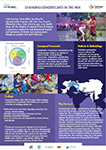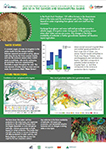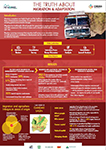Changing Gender Scapes in the HKH
Poster 2018
Understanding vulnerabilities by taking the intersectionality of gender with other axes of social differentials (class, caste, ethnicity, age, race, health) along with the interplay of external drivers of changes is important to capture the multi-dimensional impacts and implications of climatic and socioeconomic changes on people’s lives and livelihoods.
Glacier and Snow-melt Crucial for Agriculture in the Indus Less so in the Ganges and Brahmaputra Basins
Poster 2018
In the Hindu Kush Himalaya, 130 million farmers in the downstream plains of the Indus and the north-western part of the Ganges basin
depend on water originating from glacier and snow melt from the mountains.
Discharge from glacier and snow melt and groundwater provide a reliable supply of irrigation water during parts of the growing season
when other water sources are scarce. Any changes in the future availability of meltwater or further groundwater depletion will therefore
impact agriculture.
The Truth About Migration and Adaptation
Poster 2018
Mountain ecosystems are highly fragile and the livelihoods of mountain people and those of downstream communities are extremely vulnerable to various changes, including global environmental changes.
Migration has traditionally offered people the opportunity to escape socioeconomic and other pressures in their areas of origin and to diversify livelihoods and cope with risks.
Despite a growing consensus that migration itself serves as an adaptation strategy, it is still perceived as a challenge to development and the policy narrative focuses on reducing migration.
Water in Himalayan Towns
Poster 2018
People are flocking to their nearest urban centers for employment and related economic opportunities.
- 1
- 2




